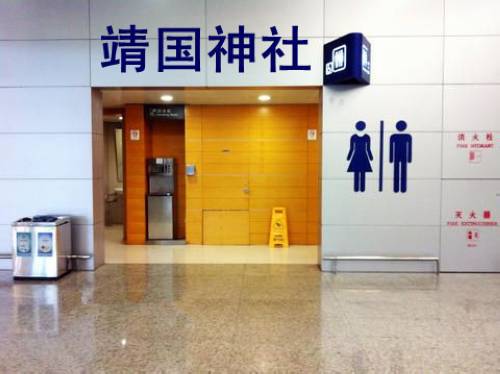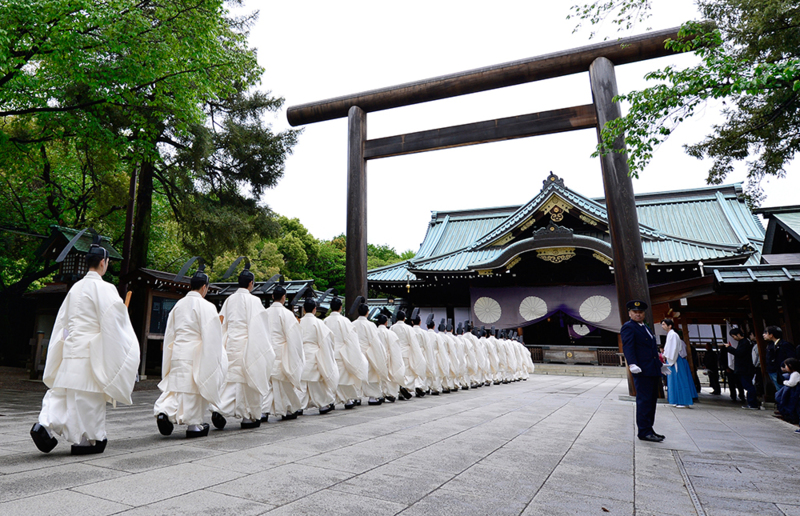

 字體:小 中 大
字體:小 中 大 |
|
|
|
| 2013/04/29 06:34:04瀏覽2914|回應18|推薦130 | |
|
Japan’s no-apology diplomacy: Why a small Tokyo shrine is causing big trouble in Asia Max Fisher | April 23, 2013 | The Washington Post | 翻譯: abcteddy
Just one year after Emperor Meiji proclaimed the Japanese Empire in 1868, he ordered the construction of a majestic new Shinto shrine in Tokyo. The Yasukuni Shrine was to record the names of every man, woman and child who died in service of the new empire. And it was to be a place of worship, part of a larger effort to make the empire something of a state religion. By the time Japan collapsed in defeat at the end of World War II, more than 2 million names had been added to the shrine. 靖國神社作為日本皇室使命的象徵已經有75年的歷史,兩者在日本均擁有至高無上的地位。無論是日本士兵,日本海外殖民侵略者還是那些為了推行日帝國主義侵略而給東亞國家及美國帶來巨大戰爭傷痛的為日本獻身的人的亡靈都可以在此安歇。 For more than 75 years, Yasukuni was a symbol of Japan’s imperial mission; both were officially sacred. The shrine was considered the final resting place of Japanese soldiers, colonists and others who served the imperial expansion that had plunged all of East Asia and eventually the United States into a costly and horrific war. 1945年日本宣布投降,日本帝國時代正式落下帷幕,曾被奉若神明的日本國家意識也隨之終結。翌年4月,在美國軍隊占領并控制日本不到一年的時間後,美國下令日本裕仁天皇永遠不得親自或是派使臣參拜靖國神社,上述史實收錄在美國人Herbert Bix曾獲2001年普利策紀實文學獎的「日皇裕仁和他所成就的現代日本」一書當中。這座曾經代表著日本征服精神永存的神社,和具有同樣象徵意義的日皇自此永別。但與此同時,神社依然新增了那些因為犯下滔天罪行而被美國認可的國際法庭處決的日本二戰戰犯首領的靈位。 When Japan surrendered in 1945 and its imperial era ended, so too, officially, did the state ideology that had been theologically enshrined at Yasukuni. That next April, less than a year after U.S. occupation forces took control of Japan, the Americans ordered Emperor Hirohito to never again visit the shrine or send envoys there, according to Herbert Bix’s Pulitzer-winning biography of the emperor. The official symbol of Japan’s supposedly divine mission of conquest would remain standing, much like the institution of the emperor himself, but the two could never again meet. Meanwhile, the shrine’s keepers continued adding names — including those of high-profile war leaders who were convicted of war crimes and put to death by U.S.-sanctioned tribunals. 1952年10月,美國結束佔領日本後不久,裕仁就恢復了前去參拜靖國神社的活動。其後,他更是參拜了七次之多。 “就像是(美軍)從未占領過日本一樣,或至少從未有過絲毫改變,”Bix在他的傳記中如是寫道。 “鑒于靖國神社對於日本侵略戰爭曾發揮過至關重要的宗教影響力,對於如何廢除它的這個功能這件事情,裕仁表現出一副完全不在乎的態度。” In October 1952, shortly after the U.S. occupation ended, Hirohito resumed his visits to worship at Yasukuni. He made seven more trips after that. “It was as if there had been no occupation, or at least no reforms,” Bix wrote in his biography. “He was completely indifferent to Yasukuni’s disestablishment from the state for its role in channeling religious energy into war.”
(照片取自美國華盛頓郵報) 和諸多戰後日本所作的妥協以及曝露出的矛盾一樣,靖國神社在日本國家身份認同方面的地位問題一直懸而未決。日本也從未像它的盟友德國那樣認真懺悔過。也因此,靖國神社不斷引發麻煩。 Like so many of the compromises and contradictions of post-war Japan, Yasukuni’s place in the national identity has never been fully resolved. And, like the imperial history that Japan has never addressed quite as fully as did wartime ally Germany, Yasukuni continues to cause trouble. 上周日,盡管日本首相安倍晉三沒有前往參拜,但三個日本高層政客從安倍手中接過了參拜木牌前往靖國神社祭拜。中國和韓國,這兩個曾慘遭過日本侵略過的,一直譴責日本罔顧歷史,否認殘暴罪行的受害國發出怒吼,嚴正抗議日本此舉。但周二,又有超過168名的日本政府官員參拜神社,遠遠超過了往年參拜的人數。 On Sunday, three high-level Japanese politicians visited Yasukuni, bringing along a wooden token from Prime Minister Shinzo Abe, who did not visit. China and South Korea, both of which suffered heavily under imperial Japan and who have long accused Japan of refusing to fully atone for or even recognize its wartime abuses, howled in protest. On Tuesday, 168 more Japanese government officials arrived at the shrine, far more than usually attend the annual pilgrimage. 用言語很難講述東亞諸國是如何地厭惡靖國神社,因為它一定程度上已经成為日本的象徵,東亞地區對它由來已久的積怒現已達到了相當危險的程度。2011年12月,一名華籍男子試圖用自製炸藥放火燃燒靖國神社,後來他在韓國被捕并供認其行為。韓國拒絕了日本方面引渡并監禁該名男子的外交要求,并宣布該男子會在韓國囚禁數月之後被遣返回中國。就在上個月,中國安徽省合肥市的一家餐館老闆因為把自家餐廳的洗手間命名為“靖國神社”而一度在網絡上聲名大噪。 It’s hard to overstate just how hated Yasukuni is in East Asia, the degree to which this shrine has become a symbol of Japan’s role in the long-held regional tensions that have recently simmered into something a bit more dangerous. In December 2011, a Chinese man attempted to burn the shrine with homemade explosives, a crime he confessed to only when he was later arrested in South Korea for trying to attack the Japanese Embassy in Seoul. But South Korea refused to extradite the man to Japan for imprisonment there, announcing that he would instead be sent home to China after serving a few months’ time in Korea. Last month, a restaurant owner in the Chinese city of Hefei became a minor celebrity on the Chinese Web for putting a sign reading “Yasukuni Shrine” over the restaurant’s toilets. 
(照片源自鳳凰網) 在過去的一年裏,中日兩國的民族主義空前高漲,韓國的情況稍好一些。把這幾個國家帶入危險境地的竟是一些存在爭議的小島嶼。而且最近的這次參拜事件不僅將之前各國為緩和緊張關系做出的努力化為烏有,更是火上澆油讓彼此間的情勢劍拔弩張起來。包括外交部長在內的韓國官員取消了對日本的訪問計劃以此表達此抗議。日本國會議員也不得不取消訪華計劃因為中國領導人習近平是很難接見他們的。一位日本反對黨的國會議員警告說日本將會為此(取消訪華)付出沉重代價。 The last year has seen rising nationalism in Japan and China, and to a lesser degree in South Korea, lead the countries dangerously close to war over a handful of tiny, disputed islands. The recent visits to Yasukuni seem to have substantially set back the efforts to make up and to have worsened tensions. South Korean officials, including the foreign minister, canceled their visit to Japan in protest over the pilgrimage and Abe’s visit to the shrine. Japanese lawmakers said they had to cancel a trip to China because Chinese leader Xi Jinping was being “too difficult” about setting up meetings. A Japanese lawmaker with an opposition party warned that his country was paying a heavy cost for the visits. 安倍政府看來不僅已經找到其他辦法來激怒鄰國而且還放任國內的民族主義情緒。他不僅否認了被中韓,東南亞諸國完整記錄在冊的日軍強征慰安婦的罪行,還表示可能會“修改”日本對以上諸國在戰時所犯罪行的道歉。某個日本右翼智庫一直以來都持這種主張并敦促日本政府放棄過去所謂的“道歉外交”改為“不道歉外交”。 Abe’s administration has found other ways to infuriate Japan’s neighbors and indulge nationalism at home. He has denied the Japanese military’s well-documented enlistment of Chinese, Korean and Southeast Asian sex slaves during the war and suggested he may want to “revise” the country’s national apology for wartime abuses. A right-wing Japanese think tank has advocated for such moves, urging that Japan abandon what it called “apology diplomacy.” The more recent turn might then be called “no-apology diplomacy.” 那麼日本政要因何要堅持參拜靖國神社呢?目前尚不清楚他們在何種程度上籍此煽動民族主義或只是為了獲得執政地位,盡管在任何選舉制民主中,民心向背與公共領導力兩者間的界限不總是涇渭分明。但無論出于何種原因,(參拜)對日本的影響都好不到哪去。 即便是島嶼的爭端之時,這些國家彼此間的矛盾也從未如當前這般高漲,但是島嶼糾紛不僅傷害了每個亞洲國家的外交也無益於各自的貿易,對誰都沒好處。韓國,尤其是中國毫無疑問在此爭端中都負有相應的責任,但考慮到這些宿怨產生於二戰之中,因此日本更應該承擔起一些特殊責任。 So why do Japanese politicians keep visiting Yasukuni? It’s not clear the degree to which they are stoking nationalism or merely riding it to office, although, as in any electoral democracy, the forces of popular sentiment and public leadership aren’t always distinct. Whatever the cause, the effect is bad for Japan — the islands disputes, even if they never escalate beyond where they are now, have hurt both diplomacy and trade — and bad for Asia. South Korea and particularly China without question share responsibility for those disputes, although given that the anger and resentment in East Asia can in many ways be traced back to World War II, Japan perhaps holds some special responsibility. 正如歷史學家W.R. Mead在自己博客中所寫的,“由於中日不曾像二戰後的德法那樣曾敞開心扉進行過深度的和談,因此亞洲仍是一個動盪危險的地方。” As the historian W.R. Mead wrote on his blog, “Because Japan and China have never been able to have the kind of meeting of the minds and deep reconciliation that Germany and France had after World War II, Asia remains a turbulent and dangerous place.” 說動盪危險或許是言過其實了點。歐洲各國能相安無事除了冷戰的緣故外還因為德國努力在彌補自己犯下的過錯。但東亞各國仍糾結於不久前的那場戰爭回憶之中而無法自拔卻是真真切切的事。當日本政客祭拜供奉靖國神社之時,他們有意無意間也在往被它傷害過的鄰國的傷口上撒鹽。那個時代已經結束了。日本的經濟萎縮,人口下降,中韓的國力和地位卻在冉冉上昇。戰後歐洲國家間彼此合作,和諧共處,彼此受益。只要日本領導人繼續活在過去,仍像裕仁那般通過參拜神社去緬懷那個已經消亡了的惡名昭彰的帝國,他們就得為這個國家的命運前後奔忙。 Turbulent and dangerous might be a tad of an overstatement, and Europe was partially aided by the common cause of the Cold War as well as by Germany’s efforts to make amends, but it’s true that East Asia is still divided by the memory of the not-so-far-back war that had torn it apart. When Japanese politicians pay tribute to the Yasukuni shrine, they are also paying tribute, whether they intend to or not, to an imperial order in which Japan violently subjugated its neighbors. That era is over: Japan’s economy is shrinking and its population declining as both China and South Korea rise in power and stature. Like post-war Europe, it’s a place where cooperation and harmony are more likely to serve the interests of individual nations. But as long as Japan’s leaders continue living in the past, as Hirohito did when he resumed visiting the imperial shrine to his devastated and discredited empire, they will struggle to prepare their country for its future. 文章出處:2013年4月23日美國華盛頓郵報英文網絡版 說明:文章由本人翻譯,如需轉載請與我聯系。 延伸閱讀: 1.美國普利策獎得主Herbert P. Bix 披露“裕仁天皇根本不是傀儡”(簡,繁,英) 2.橋下徹慰安婦必要論 石原力挺 (2013年5月14日 中央通訊社) 3.裕仁天皇被釘上恥辱柱 (簡體) 4.War Responsibility and Historical Memory: Hirohito’s Apparition (英文論文) 5.安倍右傾主義是否會讓日本孤立於亞洲諸國 (香港鳳凰衛視 視頻) |
|
| ( 時事評論|國際 ) |










